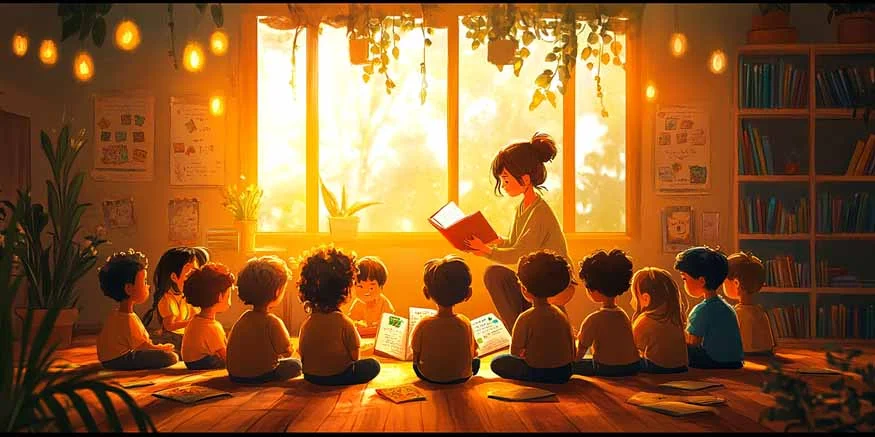“Stories are a great way to connect with people. They can be a source of inspiration and learning.” — Sudha Murty
In today’s classrooms, teaching methods are continually evolving to engage students more effectively. Storytelling, a time-honoured approach, has seen a resurgence, enriched by popular media. From films to social platforms, narratives are everywhere, offering opportunities to spark creativity, empathy, and critical thinking. At EuroSchool, storytelling is woven into teaching, creating an engaging, holistic learning experience. This blog explores storytelling’s value in education, showcasing EuroSchool’s innovative approach and offering practical tips for teachers to implement storytelling in their lessons.
Breaking Down Storytelling: The Essential Elements
Before diving into popular media examples, let’s unpack the structure of storytelling:
- Plot: The rollercoaster of events that keeps us hooked.
- Characters: The vibrant personalities making every twist unforgettable.
- Setting: The stage where the drama and excitement unfold.
- Conflict: The challenges that make the story a page-turner.
- Resolution: The satisfying conclusion tying up loose ends.
Storytelling as a Teaching Method
Storytelling is a classroom game-changer, far beyond bedtime tales:
- Engagement: A captivating story draws in students, making lessons memorable by stimulating multiple areas of the brain.
- Cognitive Boost: Stories fuel imagination, helping students grasp complex ideas and link concepts.
- Cultural Insight: Through stories, students explore diverse cultures and perspectives, broadening their worldview.
- Soft Skills: Storytelling enhances communication and presentation skills, boosting confidence and self-expression.
How to Teach Storytelling
Teaching storytelling involves a blend of structure and creativity:
- Start with Simple Stories: Begin with short, engaging tales like Charlie and the Chocolate Factory, where Charlie’s adventure sparks curiosity.
- Teach Narrative Structure: Stories like Charlie and the Chocolate Factory illustrate a simple beginning, middle, and end. Show students how to build stories using this framework.
Teaching Storytelling Through Movies
Movies provide a visual way to explore plot structures. At EuroSchool, film excerpts illustrate narrative stages:
- Introduction: Charlie and the Chocolate Factory introduces us to the whimsical world of Charlie and the eccentric Willy Wonka.
- Rising Action: In The Call of the Wild, Buck’s transformation from pampered pet to wilderness hero builds suspense with each new challenge.
- Climax: The thrilling peak in Charlie and the Chocolate Factory unfolds when the children realise the high stakes of Wonka’s magical factory.
- Falling Action: The Call of the Wild shows Buck settling into his new role, bringing the adventure to a gentle close.
- Resolution: Charlie and the Chocolate Factory wraps up with Charlie’s dream fulfilled, as he wins the factory, creating a satisfying conclusion.
Setting the Scene with Books
Books provide rich examples of how settings influence stories:
- Descriptive Language: In Black Beauty, Anna Sewell’s vivid descriptions bring the countryside to life, letting readers feel each breeze and hear every rustle.
- World-Building: Sudha Murty’s Grandma’s Bag of Stories transports readers to diverse settings, from bustling village markets to cosy homes, making each locale central to the story.
- Atmosphere: In Black Beauty and Murty’s stories, the setting establishes mood—lush meadows evoke calm, gloomy stables signal struggle, and warm, nostalgic settings in Murty’s tales create inviting atmospheres.
Settings are not just backgrounds; they’re the magical worlds that make narratives unforgettable!
Unpacking Drama: Conflict and Resolution
Exploring conflict and resolution helps students appreciate the story’s depth:
- Types of Conflict: In Black Beauty, the protagonist faces internal and external conflicts. Externally, he endures cruel treatment; internally, he struggles to retain dignity amid adversity.
- Resolution Strategies: Black Beauty concludes with a bittersweet resolution. Although Beauty eventually finds a kind owner, his journey is marked by hardship and loss, offering a complex, nuanced ending.
Examining Black Beauty shows how conflicts and resolutions shape narratives, adding emotional depth and impact.
Bringing Stories to Life Through Classroom Activities
Turn storytelling concepts into engaging, hands-on adventures:
- Media Detective Work: Students become narrative sleuths by watching film adaptations of novels. Their mission? Spot and analyse elements like conflict, resolution, and setting—like a scavenger hunt for storytelling clues!
- Creative Story Labs: Students unleash their inner storytellers, creating character sketches, designing book covers, and even mapping out fictional worlds. Imagine creating your own book cover or drawing a map of an epic adventure!
- Storytelling Show-and-Tell: In lively group discussions, students present their projects, gaining insight into storytelling techniques and learning creative tips from each other.
These activities let students play with storytelling elements and bring their favourite novels and new creations to life!
Pic Credit: iStock
Conclusion
Teaching storytelling through popular media captivates students and deepens their understanding of narrative elements in relatable contexts. They gain a greater appreciation for storytelling techniques, which they can apply to their own creative writing. By examining the plots, characters, and themes in films, books, and TV shows, students gain insights into how stories are crafted. At EuroSchool, we are committed to making storytelling a dynamic learning experience, helping students hone their creativity, critical thinking, and communication skills—skills that will serve them well in academics and beyond.









